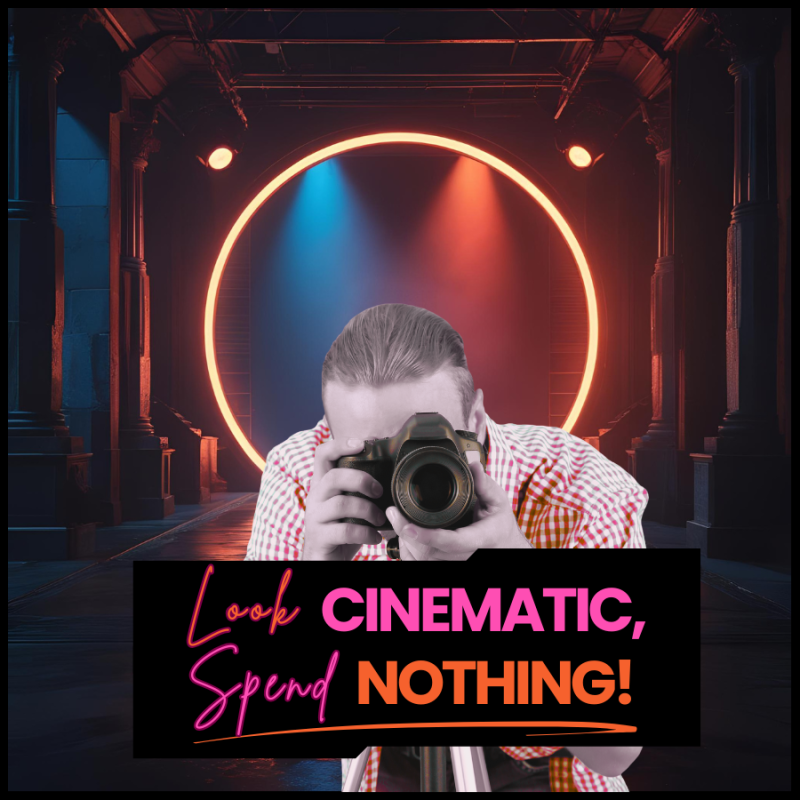When it comes to indie filmmaking, the phrase “use what you have” isn’t just practical advice—it’s a creative superpower. You don’t need a $50,000 camera rig to make a visually stunning film. You need to understand the tools you do have, and how to use them with intention.
Whether you’re filming on a DSLR, mirrorless camera, or even a smartphone, achieving a cinematic look comes down to mastering a few essential elements: lighting, composition, camera settings, and movement.
Here’s how to elevate your cinematography without blowing your budget:
1. Understand Your Camera
Even entry-level cameras and phones come packed with features that, if used properly, can deliver striking visuals.
🎥 Start with these basic settings:
- Frame rate: Use 24fps for that “cinematic” motion blur.
- Shutter speed: Keep it roughly double your frame rate (e.g., 1/50 for 24fps).
- ISO: Keep it as low as possible to reduce grain.
- White balance: Set it manually to avoid color shifts in post.
📱 Pro Tip: Shooting on a smartphone? Use a manual camera app like Filmic Pro or ProTake to gain more control over focus, exposure, and frame rate.
2. Light With Intention—Not Price
Lighting is the most important element in cinematography—and it doesn’t have to cost a fortune.
💡 DIY Lighting Tricks:
- Use natural light wisely: Golden hour is your best friend.
- Bounce light: White foam boards or cheap reflectors can soften shadows beautifully.
- Household lamps: Swap bulbs for warmer or cooler tones as needed.
- Blackout material: Use trash bags or black cloth to block light and shape shadows.
🎬 Create contrast, depth, and emotion by lighting with a purpose—not just brightness.
3. Composition Is Free
No matter what camera you use, strong framing makes all the difference.
📐 Master the basics:
- Rule of thirds: Place your subject off-center to create visual interest.
- Leading lines: Use architecture or nature to guide the viewer’s eye.
- Foreground elements: Add layers for depth.
- Headroom and lead room: Keep shots balanced and emotionally expressive.
📸 Practice framing by storyboarding your scenes or studying stills from your favorite films.
4. Use Movement to Add Emotion
Cinematic movement doesn’t require a dolly or crane. Handheld, when done right, can feel intimate and dynamic.
🎥 DIY Movement Ideas:
- Use a gimbal or smartphone stabilizer for smooth shots.
- Try the “poor man’s dolly”: a skateboard, wheelchair, or slider made from PVC pipe.
- Tripod + pan/tilt head: Simple, clean, and classic.
- Handheld with intention: Adds tension, realism, or intimacy.
🔥 Key Tip: Let movement serve the story. Don’t move the camera just because you can.
5. Color Grade with a Cinematic Eye
Even with basic editing software, you can tweak your footage to elevate the look.
🎨 Color Grading Tips:
- Shoot in a flat or log profile if possible, to retain dynamic range.
- Boost contrast and shadows for drama.
- Use LUTs (Look-Up Tables) to create a consistent mood.
- Match color temperatures across shots for a professional finish.
You don’t need DaVinci Resolve to get started—tools like Adobe Premiere, Final Cut, or even CapCut can do wonders.
6. Audio Still Matters
While not “visual,” poor audio can ruin an otherwise beautiful shot. Always use an external mic when you can—even if it’s just a $20 lav.
🎧 Bad audio makes your film feel amateur, no matter how good it looks. Good audio? It elevates everything.
7. Study Films Made on a Budget
Some of the most visually impressive indie films were made on shoestring budgets.
🎞️ Examples:
- Primer (2004): Shot for ~$7,000
- Tangerine (2015): Filmed entirely on iPhones
- The Fits (2015): Simple setups, masterful visual storytelling
Study how these directors used light, framing, and movement to make their limitations invisible.
Cinematic isn’t about equipment. It’s about vision.
When you learn to harness light, compose with intention, and move your camera with purpose, even the simplest tools become powerful.
As an indie filmmaker, your constraints are not obstacles—they’re part of your style. Master them, and you’ll create work that looks—and feels—like cinema.
Transformational Screenwriting
At the Independent Film Arts Academy (IFAA), we believe great visuals begin with great storytelling. If you want to deepen your visual storytelling foundation, check out the book Transformational Screenwriting on Amazon.
📘 Get your copy now and bring your stories to life—cinematically.

